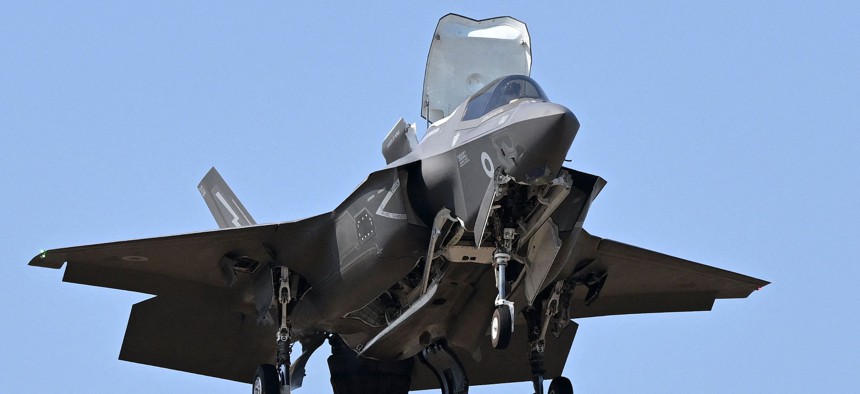
A Lockheed Martin F-35 fighting jet takes part in a flying display at the Farnborough Airshow, in Farnborough, on July 19, 2022. AFP via Getty Images / JUSTIN TALLIS
The Air & Space Brief: UK’s new fighter set to fly in five years; Sweden studying new jet amid NATO bid; Space priorities in the NDAA
Welcome to the Defense One Air and Space newsletter. Here are our top stories this week:
Timeline set for new UK jet flight: Britain is expected to fly a prototype of its next-generation combat jet within the next five years, officials announced Monday at the Farnborough Air Show outside London, where extreme temperatures are melting runways. There’s less secrecy surrounding the British program than there is about the similar American next-generation fighter jet program. While the Air Force will only say a competition is underway, the Brits have already announced which companies are working on Tempest.
For more Farnborough coverage, follow Defense One’s Global Business Editor Marcus Weisgerber and Deputy Editor Brad Peniston on Twitter.
Sweden’s new strategy: As nations consider Sweden’s application to join NATO, the country’s military is ramping up its defense spending, crafting a new national defense strategy, and paying Saab to study development of a new fighter jet. Swedish Air Force Chief Maj. Gen. Carl-Johan Edstrom said this week that Russia’s invasion of Ukraine and Stockholm’s expected accession in NATO are driving the changes.
ICYMI: Senators are meeting Tuesday afternoon to take the first steps to consider Sweden and Finland’s applications to join NATO.
Inside the NDAA: Lawmakers approved several space-focused amendments to the House version of the NDAA before passing the bill late Thursday night. The changes, which will have to survive conference with the Senate to become law, include a new report on the national security risks of space debris, and a review of Space Force staffing requirements for cyber squadrons.
The push for a Space National Guard: Two senators—Dianne Feinstein, D-Calif., and Marco Rubio, R-Fla.—are arguing that the Senate must approve language in the House-passed NDAA to create a Space National Guard. When the Space Force was established in 2019, space units within the Guard remained in the Air Force, since there was no space Guard to which they could transfer. This keeps the military’s space forces stovepiped, which is exactly what lawmakers were trying to avoid.
“Our space units should operate as a seamless team, but they can’t do that while divided between two services,” the senators wrote in an op-ed. “The division also makes it impossible to build a strong organizational culture.”
Sign up to get The Air & Space Brief every Tuesday from Tara Copp, Defense One’s Senior Pentagon Reporter. Jacqueline Feldscher, Defense One’s Senior National Security Reporter, is filling in this week while Tara is on assignment. On July 19, 1985, President George H.W. Bush announced that high school teacher Christa McAuliffe would become the first American civilian in space. McAuliffe and six other members of the crew were killed six months later when the space shuttle Challenger broke apart after liftoff.
 From Defense One
From Defense One
Hypersonic Missile-Tracking Satellites Greenlit For Development // Lauren C. Williams
The Space Development Agency awarded L3Harris and Northrop Grumman $1.3 billion in contracts to deliver prototypes that track quick-maneuvering hypersonic missiles in flight.
Boeing's Fighter Jet Business Is Not Dead Yet, New Defense Boss Says // Marcus Weisgerber
"We're investing," says Ted Colbert, outlining company plans on the eve of Farnborough Air Show.
US Can't Down Russian Missiles Being Used in Ukraine, Report Says // Marcus Weisgerber
Building a defense against cruise missiles will cost billions, CSIS concludes.




